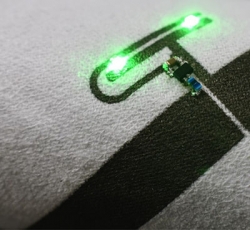Some of the new Products on Show
Next-gen technologies for soft circuitry build
Liquid X
 Liquid X utilizes its proprietary, particle-free conductive inks as the enabling technology for soft circuitry
Liquid X utilizes its proprietary, particle-free conductive inks as the enabling technology for soft circuitry
builds. Instead of sewing in bulky wires, or printing on an interface layer that is heat laminated onto fabric,
the company utilizes inkjet printing to conformally coat the threads of fabric, creating highly conductive traces directly in the fabric while maintaining the integrity of the fabric (the ink acts almost as a dye on the
fabric, so the feel is unchanged to the user) and minimizing steps in the manufacturing process of soft circuits.
The company’s ability to coat and maintain performance through durability on a wide array of fabrics, including many nonwovens and automotive trim materials, along with its engineering design and build expertise, allows Liquid X to work directly with customers to take an application from concept to commercialization. Its inkjet printing process is scalable to high-volume manufacturing, as it has demonstrated on a 2.2m-wide web roll-to-roll print system. Soft circuit products developed include
force sensors, capacitive touch sensors, LED lighting arrays, heating panels, sensors for monitoring of vital
signs, antennas and many more.
In addition, the prototype smart seat developed by Liquid X includes a printed heating element along with a printed control circuit to incorporate multiple components into one device: a fully integrated seat heater with automated temperature control, built-in touch controls and LED indicators. The smart seat includes four set points: low, medium, high and off. Automated temperature controls are included via a printed temperature sensor to regulate the temperature of the seat at each set point. The printed touch sensor allows the user to adjust the set points directly on the seat.
Lastly, the four LED indicators let the user know the current set point of the seat. The heating element and circuitry can be printed directly on the B side of automotive trim or on a thin fabric layer that can be sandwiched between the automotive trim and the foam layer. By moving the heating element closer to the body, the printed heater can provide faster and more uniform heating for the user while potentially reducing power consumption in the vehicle.
Booth: A308
